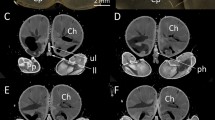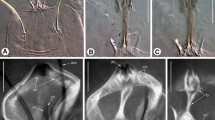Abstract
Structural details of the areas around the mouth opening in centipedes (Chilopoda) have not previously been studied comparatively, though descriptions of single representatives of the major groups indicate conspicuous variability. In order to clarify its phylogenetic significance, the roof of the preoral chamber (epipharynx) and its bottom (hypopharynx) have been examined for 17 species that sample 11 genera of Scutigeromorpha. The survey by light and scanning electron microscopy includes representatives of each of the major subgroups (Scutigerinidae, Pselliodidae, Scutigerinae and Thereuoneminae). The detailed morphology of the peristomatic areas is similar in all species. The three major subgroups Scutigerinidae, Pselliodidae and Scutigeridae are each distinguished by the structure of the lateral rows of labral bristles and details of the epipharyngeal sensilla. By comparison to pleurostigmophoran chilopods, several characters of the hypopharynx and epipharynx can be identified as autapomorphic for Scutigeromorpha. The pselliodid Sphendononema shares a few apparent synapomorphic characters with Scutigeridae to the exclusion of the Scutigerinidae, providing additional morphological support for Scutigerinidae being sister group of all other Scutigeromorpha.












Similar content being viewed by others
References
Altner H, Loftus R (1985) Ultrastructure and function of insect thermo- and hygroreceptors. Ann Rev Entomol 30:273–295
Attems C (1928) The Myriapoda of South Africa. Ann S Afr Mus 26:1–431
Barth FG (1986) Zur Organisation sensorischer Systeme: Die cuticularen Mechanorezeptoren der Arthropoden. Verh Dtsch Zool Ges 79:69–90
Edgecombe GD (2006) Homology of cephalic sutures in Chilopoda: the antennocellar sutures of Scutigeromorpha. Tjid Entomol 149:67–70
Edgecombe GD, Giribet G (2004) Adding mitochondrial sequence data (16S rRNA and cytochrome c oxidase subunit I) to the phylogeny of centipedes (Myriapoda, Chilopoda): an analysis of morphology and four molecular loci. J Zool Syst Evol Research 42:89–134
Edgecombe GD, Giribet G (2006) A century later—a total evidence re-evaluation of the phylogeny of scutigeromorph centipedes (Myriapoda, Chilopoda). Invert Syst 20 (in press)
Enghoff H (1981) A cladistic analysis and classification of the millipede order Julida. Z Zool Syst Evol-forsch 19:285–319
Ernst A (2000) Struktur und Verbreitung verschiedener Cuticularsensillen bei Geophilus longicornis LEACH (Chilopoda, Geophilomorpha: Geophilidae). Frag Faunistica 43:113–129
Foddai D, Minelli A, Würmli M, Adis J (2002) Scutigeromorpha. In: Adis J (ed) Amazonian Arachnida and Myriapoda. Pensoft, Sofia Moscow, pp 501–503
Haase E (1884) Schlundgerüst und Maxillarorgan von Scutigera. Zool Beitr 1:97–108
Keil TA (1998) The structure of integumental mechanoreceptors. In: Harrison FW, Locke M (eds) Microscopic anatomy of invertebrates, vol 11 B: Insecta. Wiley-Liss, New York, pp 385–404
Koch M (2003) Monophyly of the Myriapoda? Reliability of current arguments. Afr Inverts 44:137–153
Lawrence RF (1960) Myriapodes: Chilopodes. Faune Madagascar 12:1–122
Lewis JGE (1981) The biology of centipedes. Cambridge University Press, New York
Manton SM (1965) The evolution of arthropodan locomotory mechanisms, Part 8. Functional requirements and body design in Chilopoda, together with a comparative account of their skeleto-muscular systems and an appendix on a comparison between burrowing forces of annelids and chilopods and its bearing upon the evolution of the arthropodan haemocoel. J Linn Soc (Zool) 46:252–483
Minelli A (1993) Chilopoda. In: Harrison FW, Rice ME (eds) Microscopic anatomy of invertebrates, vol 12: Onychophora, Chilopoda, and lesser Protostomata. Wiley-Liss, New York, pp 57–114
Ravoux P (1975) Endosquelette et musculature céphaliques de Scutigerella immaculata Newport (Symphyla: Scutigerellidae). Bull Mus natl Hist nat, 3e sér., Zool 234:1189–1238
Rosenberg J, Brenner M, Greven H (2004) Putzverhalten und Trinken bei Scutigera coleoptrata L. (Chilopoda, Scutigeromorpha). Entomol Heute 16:83–92
Seifert G (1967) Der Pharynxapparat von Scutigera coleoptrata L. Z Morphol Tiere 58:347–354
Snodgrass RE (1952) A textbook of arthropod anatomy. Hafner Publ, New York
Takakuwa Y (1955) Morphology and classification of the Scutigera, with a memory of the late Dr Asajiro Oka. Gakufû-Shoin, Tokyo
Verhoeff KW (1902–25) Chilopoda. In: Bronn HG (ed) Klassen und Ordnungen des Tierreichs, vol 5 (2), Buch 1. Akad. Verlagsges., Leipzig, pp 1–725
Verhoeff KW (1926–28) Diplopoda. In: Bronn HG (ed) Klassen und Ordnungen des Tierreichs, vol 5 (1), Buch 2. Akad. Verlagsges., Leipzig, pp 1–1071
Verhoeff KW (1944) Eine neue Scutigeriden-Gattung aus Brasilien. Zool Anz 144:195–200
Würmli M (1978) Synopsis der neotropischen Pselliodidae (Chilopoda: Scutigeromorpha). Stud Neotrop Fauna Environ 13:135–142
Würmli M (2005) Revision der afrikanischen Pselliodiden (Chilopoda: Scutigerida: Pselliodidae). Schubartiana 1:3–8
Zacharuk RY (1985) Antennae and sensilla. In: Kerkut GA, Gilbert LI (eds) Comprehensive insect physiology, biochemistry, and pharmacology, vol 6: nervous system: sensory. Pergamon Press, Oxford, pp 1–69
Acknowledgments
This collaboration was facilitated by an Australian Museum Visiting Fellowship to M.K. We thank Sue Lindsay (Australian Museum) for operating the SEM and assisting with specimen preparation. Thanks are also due to Verena Bärmann (Freie Universität Berlin) who contributed some histological sections, and Peter Adam (Freie Universität Berlin) for making the drawings. Samples from Madagascar were provided by Charles Griswold and Darrell Ubick (California Academy of Sciences) from fieldwork funded by NSF Grant DEB-0072713. Collections from Central Asia were contributed by Lorenzo Prendini, funded by NSF Supplementary Grant EAR-0313698. Additional material was kindly loaned by Laura Liebensperger and Gonzalo Giribet (Museum of Comparative Zoology, Harvard University), James Boone (Field Museum of Natural History), and Nikolaj Scharff (Zoological Museum, University of Copenhagen). Wolfgang Dohle (Freie Universität Berlin) and Pavel Stoev (National Museum for Natural History Sofia, Bulgaria) provided valuable comments on the manuscript. G.D.E.’s research on Scutigeromorpha is supported by Australian Biological Resources Study Grant 205–08.
Author information
Authors and Affiliations
Corresponding author
Rights and permissions
About this article
Cite this article
Koch, M., Edgecombe, G.D. Peristomatic structures in Scutigeromorpha (Chilopoda): a comparative study, with new characters for higher-level systematics. Zoomorphology 125, 187–207 (2006). https://doi.org/10.1007/s00435-006-0027-8
Received:
Accepted:
Published:
Issue Date:
DOI: https://doi.org/10.1007/s00435-006-0027-8




